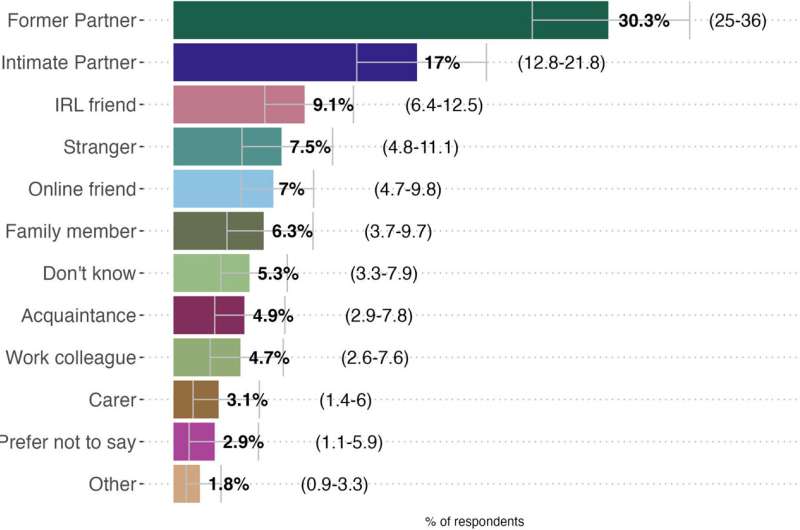This article has been reviewed according to Science X's editorial process and policies. Editors have highlighted the following attributes while ensuring the content's credibility:
fact-checked
peer-reviewed publication
trusted source
proofread
Study finds 1 in 7 adults have experienced someone threaten to share their intimate images

A global study on the prevalence of sexual extortion among adults has found the issue to be more widespread than initially thought. The study, "Sextortion: Prevalence and correlates in 10 countries," was published in Computers in Human Behavior
Sexual extortion, or sextortion, is a form of image-based sexual abuse which includes making threats to share intimate photos or videos of a victim unless they comply with the perpetrator's behavioral or financial demands.
The research, led by RMIT University in partnership with Google, surveyed over 16,000 adults across Australia, North and Central America, Europe and Asia and found 14.5% of respondents reported being victims of sextortion, while 4.8% admitted to being perpetrators.
LGBTQ+ people, men and younger respondents were more likely to report both victimization and perpetration.
The most common type of perpetrator was a former or current partner, but men were more likely than women to report being victimized by a colleague or caregiver.
Victimization was most common in the US, Australia, Mexico and South Korea, and least common in the European countries.
Perpetration was most common in South Korea, followed by Australia and the US. It was least common in Belgium, the Netherlands, Poland and Spain.
Despite men being more likely to be perpetrators, the study found they were also slightly more at risk of being victims of sextortion.
Lead researcher and RMIT Professor Nicola Henry said one possible explanation for why men are more likely to report victimization could be because sextortion scams were more likely to target young men.
"For financial forms of sextortion, scammers trick people into sharing their intimate images, or lead them to believe they have evidence of the victim visiting pornographic sites," said Henry, from RMIT's Social Equity Research Center.
"They then use this evidence to threaten to share intimate images if they don't comply with their demands, like paying money or sending more intimate images."
Despite the prevalence of sextortion in the form of financial scams, Henry said sextortion was actually more likely to be perpetrated by an intimate partner.
"This is particularly common in intimate partner abuse where a partner or an ex threatens to share intimate images to coerce the victim into doing or not doing something, such as staying in the relationship, pursuing an intervention order, refusing custody of children, or engaging in an unwanted sexual act," she said.
LGBTQ+ people were also at a greater risk of falling victim to sextortion, where intimate content might be used as a threat to 'out' them due to the stigma surrounding sexuality and sexual freedom of expression.
Co-author and Staff User Experience Researcher at Google, Dr. Rebecca Umbach, said there was little existing research into sextortion among adults, with the majority focused on minors or specific locations.
"A lack of standardized large-scale data can hinder our ability to effectively address the issue," she said.
"Even assuming some amount of under-reporting, our findings indicate that sextortion among adults is actually relatively common and deserves more research and resources."
The victim-offender overlap
The study found 85.2% of perpetrators also reported being victimized at some point.
"One possible explanation for this is that intimate images may be used in retaliation or in "tit-for-tat" situations, whereby an individual who has threatened to share another person's intimate images then experiences a threat themselves from that individual or from someone else," Henry said.
Surprisingly, South Korean women had the highest victim-offender overlap, with 15.2% of women reporting both victim and perpetrator experiences.
While more research is needed to understand the reasons for this, one possible explanation was simply the high prevalence of image-based sexual abuse in South Korea.
In this study alone, 19.1% of South Korean women reported being victims of sextortion.
"We can only hypothesize that being threatened with intimate image dissemination could prompt some people to retaliate in kind by threatening to share that person's images too," Henry said.
Combating sextortion
Given the global prevalence of sextortion, Henry said a range of measures were needed to help prevent and respond to sextortion.
"First and foremost, prevention education at the school, university, and community levels needs to be tailored specifically to at-risk groups, especially boys and young men," she said.
"More funding and resources are needed for supporting victim-survivors of sextortion, including for counseling, legal advice, and mental health crisis support.
"Frontline workers also need to be trained to recognize the signs of sextortion and respond to disclosures in a trauma-informed and culturally appropriate way, and provide appropriate supports and referrals.
"Sextortion should be part of conversations about intimate partner violence and dating abuse, not just in the context of financial scams."
With technology increasingly being used to facilitate sextortion, Umbach said studies such as this one were important to inform society as a whole, and to enable technology companies and regulators to exercise the shared responsibility to enforce policies and practices to detect, prevent and respond to sextortion.
Google hopes the research will help expand the understanding around the harms of image-based sexual abuse and support further investment in innovation to combat the issue.
More information: Nicola Henry et al, Sextortion: Prevalence and correlates in 10 countries, Computers in Human Behavior (2024). DOI: 10.1016/j.chb.2024.108298
Journal information: Computers in Human Behavior
Provided by RMIT University





















